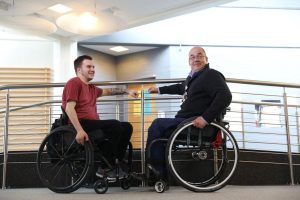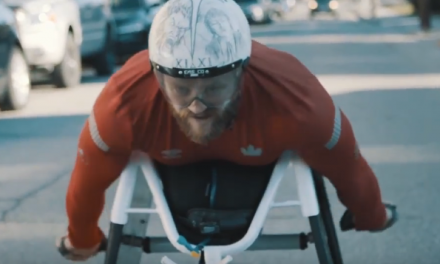 Rice, who lives in Keswick, Ont., was talking on the phone with his dad in 2016. Scott was on speaker phone when Rice’s stepmom, chimed in with a strange comment.
Rice, who lives in Keswick, Ont., was talking on the phone with his dad in 2016. Scott was on speaker phone when Rice’s stepmom, chimed in with a strange comment.
“Oh, so I hear you’re going to dance at Kate’s wedding,” she said, referring to his best friend from high school, Kate Jollymore, who was planning her wedding for the following year. It’s unclear how the rumour about Rice started, but his stepmother told him it was circulating in Bridgetown, N.S., where Rice grew up and where his dad still lived.
“I told her that’s crazy talk,” Rice says. After all, everyone back home knew he was paralyzed from the chest down, a result of a diving accident in 2012. But it got him thinking.
The accident that changed his life happened on a warm weekend afternoon at his mom’s backyard pool.
Rice had completed his first year of criminology studies at St. Thomas University in Fredericton, with thoughts of becoming a police officer. That summer he was visiting his mother in Keswick while working nearby to earn money for school.
His younger brother, Alex, had flown in from Nova Scotia and the two had spent the day at a music festival. They headed to their mom’s place, put on their shorts and jumped in the backyard pool to cool off. He had helped build the pool. He knew it had only four feet of water. Rice doesn’t remember exactly what happened. But he dove in and landed on his head with his feet straight up in the air.
Did he slip on something or miscalculate his dive? He’s not sure to this day. Afterwards, as he floated face down, he realized he couldn’t move. Except for his arms — they were flapping wildly but he wasn’t controlling them.
“I had no sensation from the bottom of my chest down,” Rice recalls. “It was terrifying.” Plus his head was in the water. He started to panic. His stepbrother, who was in the pool, rolled Rice over in the water.
Rice was later rushed to Southlake Regional Health Centre in Newmarket. That’s where an ER nurse delivered grim news to his mother and stepfather: he had crushed the front of his C7 vertebra at the base of the neck which sent a chunk of bone into his spinal cord. His family was told it was quite possible he’d never regain the use of his legs. He went on to recover significant use of his arms, but the injury caused lasting nerve damage to all four limbs.
Rice was shocked to hear the word “quadriplegic.”
Chris Rice’s accident happened June 23, 2012, less than two weeks after his 19th birthday.He was rushed to surgery at Sunnybrook hospital, where doctors performed a C7 anterior corpectomy to decompress the spinal cord. They had to carefully remove the front part of the C7 vertebra and put in a titanium plate that was secured with four screws. The plate, which Rice still has, acts as a bridge and provides structure, linking to other vertebra. Our central nervous system is made up of the brain and spinal cord. The spinal cord looks like a thick rope, cream in colour. It has nerves that send messages between the brain and our bodies. The vertebrae are the bones that form the spine and the tunnel that houses the cord.
About two weeks after the procedure, Rice was transferred to the Toronto Rehabilitation Institute’s Lyndhurst Centre in North York, which is part of a network of rehabilitation sciences centres in the city. The hospital’s mandate is to help people who have disabling injuries, illnesses or age-related conditions, live more active and independent lives.Rice credits Lyndhurst and a number of people for helping him find the courage to persevere and strive to regain the use of his legs, long before there was a friend’s wedding to serve as added motivation.
Those people include his mother, Susan Abbott, who took time off work for three years to care for Rice; kinesiologists who pushed him with aggressive physiotherapy; and a peer support worker from Spinal Cord Injury Ontario, a non-profit group that assisted him.
“Having the support is what got me … from downward spiral after the injury, to initiating the switch to thinking about life not being over and finding ways to do things that I didn’t think I’d be able to do again,” Rice says.
Spinal Cord Injury Ontario, which runs its central office in the Lyndhurst facility, provides a peer support service that has 120 volunteers. The service matches clients and staff who already have spinal cord injuries with people who are newly injured.

Chris & Ivan Rendulic
“Laying in bed, nights are the worst,” Rice says. “That’s when you’re the most vulnerable and you feel like you have no one to talk to. You can’t really text your friends because it’s hard for them to understand.”
He had troubling thoughts. Rice, single at the time of the accident, wondered who would be attracted to him given that he uses a wheelchair. And even if he found someone, would he be able to perform sexually? (He says he can, and he recently started dating someone.)
“You have so many thoughts,” he says. “I’ll never do certain things, I’ll have no future, my life is basically over. Then you get into some very dark places, where you feel you’re a burden to everyone around you. A burden to my family … to the health-care system. And that’s where suicidal thoughts creep in.”
Rendulic, the peer support worker, listened and offered insights, assuring him the emotions he was going through were common. “I opened myself and shared all the good and bad experiences I had when I was an inpatient,” says Rendulic, who now co-ordinates the peer support program.
Rendulic damaged his spinal cord in May 1994 when a tree fell on his lower back, leaving him paraplegic. He cannot use his legs. The incident happened while he was clear-cutting an area to build a retirement home for his father. Rendulic, 47, struggled emotionally and physically after his injury but “pushed and pushed through.” “Hopefully I can help alleviate some pain people are feeling and help them transition to the other part of their lives they really want to get to,” Rendulic says of his peer work.
In 2013, a year after Rice’s accident, he was determined to use his legs again. He started going to Walk it Off, a neurological rehabilitation facility in Newmarket. He would later be paired with kinesiologists who administer physiotherapy, such as Rebecca Wheeler. “When we first started working together, he really didn’t have much function below his chest,” Wheeler recalls, adding he had strong spasms in both his legs that prevented him from walking or standing.
He has used medications to help control the spasms. Meanwhile, Wheeler has taken him through a challenging physical program in which he has gone from using a harness for mobility, to a walker, to walking assisted by two people. Rebecca Wheeler practised with Rice to get him ready for the big wedding dance. But it was more than a pas de deux. “The whole clinic looked forward to him accomplishing that task,” the kinesiologist says. “We were all very excited for him.”
To get to the wedding, Rice drove for 21 hours, alone, to Nova Scotia in his Mazda 5 minivan, which he has modified to accommodate him. He can also get in and out of it on his own. The night before the ceremony, he and Kate practised during the dress rehearsal.
The wedding was on June 23, 2017 — the fifth anniversary of the accident. The time had come. He wheeled up to the dance floor. Rice got into an upright position while Scott, his dad, pulled the wheelchair backwards. Rice used his strength to raise himself with the help of his walker. His stepmom cast the walker aside.
He and Kate chose the song “Green Eyes” by Coldplay because of the line “you are the rock upon which I stand.” As he stood, Kate helped support him by gently holding him under his arms as the two softly swayed to the music. “I was shifting my weight from one leg to the other, lightly moving my hips side to side,” Rice recalls. “I was shaking from nerves … dancing in front of 200 people for the first time.” A minute or so into the song, couples paired up and joined them on the dance floor.
“I was really proud of him,” says Jollymore. “He’s come such a long way.” The moment was powerful for Rice. It was also vindication. “It was a five-year journey to that point,” he says. “It was something I was repeatedly told I’d never do.”
These days Rice continues to live in Keswick with his mother, who says she’s thrilled with everything he has accomplished since his accident. “He can do so much on his own,” says Susan Abbott, who has returned to work full time.
Aside from a busy schedule of physiotherapy and exercise at a gym, he enjoys going to concerts and car races. He has even done the EdgeWalk high atop the CN Tower — “they had me on a strap and leaned my wheelchair completely over the edge.”
And within the last three months Wheeler has worked alone with him, helping him take more footsteps.
“I face him. I walk backwards as he walks forward … I’m really just spotting him in case he gets tripped up on his toes or needs a break. I’m mostly there for safety,” she says. He can walk about 60 metres in this manner.
Overall, his level of “motivation and determination” has played a major role in Rice’s progress, Wheeler says. “He is constantly trying to better himself, which is why he’s been so successful.”
Rice also volunteers, including as a peer support mentor for Spinal Cord Injury Ontario, which he began doing in 2015. When he speaks to others he doesn’t try to force anything on anyone. He gently suggests ideas while listening and trying to be supportive.
If the subject of their recovery comes up he has to choose his words wisely, because not everyone with a spinal cord injury will have the success he has had. “Walking happens for some people, for some it doesn’t,” he says. “You can get everything back, some or nothing.”
Article originally published in the Toronto Star
By Donovan Vincent Feature Writer
Sat., May 26, 2018
Photo Credits:
Wedding – Sydney MacLennan
Lyndhurst – Rene Johnston / Toronto Star




